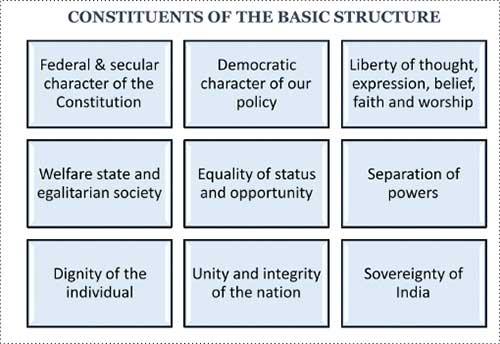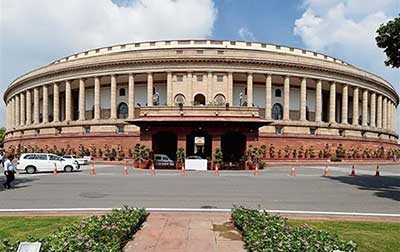Date : 06/09/2023
Relevance: GS Paper 2- Polity - Constitution
Keywords: Kesavananda Bharati judgement, Constitutional Supremacy, Separation of Power, Principles of Constitutionalism
Context-
Recently, Ex-Chief Justice of India(CJI) Ranjan Gangoi said in Rajya Sabha that the basic structure of the Constitution has a “debatable jurisprudential basis”.
What is the Doctrine of Basic Structure?
- The Kesavananda Bharati judgment introduced the Basic Structure doctrine, which placed restrictions on Parliament's authority to enact sweeping amendments that could impact the fundamental principles embedded in the Constitution. This landmark ruling affirmed the Supreme Court's authority to subject parliamentary laws to judicial review. Furthermore, it advanced the notion of the separation of powers among the three branches of government: the legislative, executive, and judiciary.
- The Doctrine of Basic Structure stipulates that Parliament's unrestricted authority to amend the Constitution is constrained by a single condition: it must not diminish or infringe upon the fundamental framework of the Constitution.
Genesis of the Doctrine of Basic Structure
The evolution of the Basic Structure doctrine can be traced from the issue of the right to property and the first Constitutional Amendment Act of 1951.

- In the case of Shankari Prasad vs. Union of India in 1951, the Supreme Court ruled that Parliament, as per Article 368, possessed the authority to modify any aspect of the constitution, including fundamental rights.
- In the subsequent case of Sajjan Singh vs. the State of Rajasthan in 1965, the Supreme Court upheld its previous decision from the Shankari Prasad case of 1951, affirming that Parliament could indeed amend any part of the constitution under Article 368. Nevertheless, it's worth noting that Justices Hidyatullah and Mudholkar, while concurring with the majority opinion, expressed reservations regarding the unrestricted power of Parliament to amend the Constitution and potentially curtail citizens' fundamental rights.
- In the Golak Nath vs. State of Punjab case in 1967, the Supreme Court reversed the Shankari Prasad judgment, asserting that Article 368 solely delineates the process for amending the constitution and does not grant Parliament unrestricted authority to amend any portion of the constitution.
- In the Kesavananda Bharati vs. State of Kerala case in 1973, the Supreme Court upheld the legality of the 24th Constitution Amendment Act. However, it modified its stance from the Golak Nath case, ruling that while Parliament possesses the authority to amend any aspect of the constitution, it must ensure that the fundamental framework of the constitution, known as the "Basic Structure," remains intact. This case is renowned for introducing the concept of the "Basic Structure of the Constitution."
- In the Minerva Mills vs. Union of India case in 1980, the Supreme Court declared certain provisions of the 42nd Constitutional Amendment Act as null and void. The Court's decision emphasized that Parliament cannot strip away the authority of "judicial review" since it constitutes an integral component of the "Basic Structure" of the Constitution.
- In the Waman Rao vs. Union of India case in 1981, the court introduced the concept of the 'Doctrine of Prospective Overruling.' It determined that laws included in the Ninth Schedule before the Kesavananda judgment could not be challenged for violating Fundamental Rights. However, it allowed the possibility of contesting laws enacted after the Kesavananda judgment in a court of law.
Elements Of Basic Structure Doctrine
- While the doctrine of the basic structure is not explicitly outlined, it has been elucidated by judicial pronouncements, outlining the framework of the constitution. Over time, this basic structure has evolved as new elements are incorporated. Consequently, the precise definition of the Constitution's basic structure remains a work in progress for the Supreme Court.

Significance of Basic Structure Doctrine
- Upholds Constitutional Ideals: The Basic Structure Doctrine aims to preserve the constitutional principles and fundamental ideals envisioned by the framers of the Constitution.
- Safeguards Constitutional Supremacy: This doctrine plays a crucial role in ensuring that the Constitution remains supreme and is not undermined by the transient majority in Parliament.
- Preserves Separation of Powers: The Basic Structure Doctrine reinforces the democratic system by establishing a clear separation of powers, ensuring the independence of the Judiciary from the other branches of government. Granville Austin contends that through the Basic Structure Doctrine, a harmonious balance has been struck between the responsibilities of Parliament and the Supreme Court in safeguarding the intricate fabric of the Indian Constitution.
- Protects Fundamental Rights: It serves as a safeguard against the arbitrary exercise of power and authoritarianism by the legislative branch, thereby protecting the fundamental rights of citizens.
- Constitution as a Living Document: Due to its dynamic nature, the doctrine makes the Constitution more adaptable and receptive to changes over time, allowing it to evolve as a living document.
The Basic Structure Doctrine stands as a testament to the principles of Constitutionalism, serving as a safeguard against the erosion of the core essence of the Constitution by an overwhelming ruling majority. This doctrine has played a pivotal role in preserving Indian democracy by imposing constraints on the constituent power. Without it, the unchecked authority of Parliament might have led India down the path of totalitarianism.
Criticisms of the Doctrine of Basic Structure
- Inconsistent with the Principle of Separation of Powers: The doctrine, while allowing for checks and balances, raises concerns when one branch oversteps its boundaries. A court's role should encompass review rather than rewriting constitutional amendments.
- Vagueness and Ambiguity of Basic Structure: The lack of a precise definition for Basic Structure leads to ambiguity, making it challenging to clearly identify its components.
- Transforming the Judiciary into a Decisive Chamber: The invocation of the Basic Structure doctrine can give the impression that the Judiciary assumes the role of a third legislative chamber, potentially diminishing the significance of Parliament's work.
- Concerns of Judicial Overreach: Recently, the doctrine has been employed in cases that some view as instances of judicial overreach. For instance, the National Judicial Appointment Commission Act, of 2014, was nullified by the Supreme Court based on this doctrine, leading to debates about the extent of judicial authority.
Judicial activism
- Judicial activism is a judicial philosophy holding that the courts can and should go beyond the applicable law to consider the broader societal implications of its decisions.
- Examples: Keshavananda Bharati case, Maneka Gandhi case
- PIL has become the major tool for giving effect to judicial activism in recent times
Judicial overreach
- Using judicial powers to interfere with the proper functioning of executive and legislature.
- Examples: Banning firecrackers, and regulations related to allowing bars near highways
Judicial review
- Judicial review is the power of courts to decide the validity of acts of the legislative and executive branches of government. Courts derive powers for their judicial review under Art 13(2), Art 32, and Art 142.
- Example: Scrapping section 66A of the IT Act.
Conclusion
In a world where democratic values are facing unprecedented challenges, the Basic Structure Doctrine remains a beacon of hope, embodying the enduring principles enshrined in India's Constitution. A robust debate on its components and boundaries invites profound reflection and the reaffirmation of India's democratic ethos.
Probable Questions for UPSC Mains Exam-
- What is the Basic Structure Doctrine, and what is its significance in terms of upholding constitutional principles and safeguarding the Indian Constitution? (10 Marks,150 Words)
- What criticisms and concerns surround the Basic Structure Doctrine, including its potential to challenge the separation of powers, ambiguity in defining the Basic Structure, and instances of perceived judicial overreach? (15 Marks, 250 Words)
Source- The Indian Express








